- Рассматриваем сделки
- How to identify trend reversal like a pro
- 2. Identify an accumulation stage on the lower timeframe (1-hour)
- Trend reversal trading setups that work
- Support & Resistance
- The Breakout
- The Pullback
- Торговый советник
- Trend reversal trading: Entries, stops and exits
- How do you time your entries in trend reversal trading?
- How to set a proper stop loss in trend reversal trading?
- Примеры
- The 4 stages of the markets and why it matters
- 1. The accumulation stage
- 2. The advancing stage
- 3. The distribution stage
- 4. The declining stage
- Do you make these mistakes in reversal trading?
- 1. You’re catching a falling knife
- 2. You’re entering on the first pullback
- Используемые индикаторы
- Summary
- Правила торговли
Рассматриваем сделки
Прежде чем приступить к торговле, нам необходимо первоначально подготовить к работе наш терминал. Для начала мы устанавливаем обычную скользящую среднюю с периодом 55. С ее помощью мы будем смотреть направление текущего тренда на рынке.
Дополнительно мы устанавливаем кастомный с тохастик, с помощью которого мы с Вами будем фильтровать текущие сделки. После этих простых манипуляций можно приступать к поиску точек входа в рынок.
Рассматривать примеры мы будем на базе валютной пары Евро-Доллар при использовании интервала М15!
Вот здесь мы видим превосходную точку на бай. Для начала, цена пересекает в восходящем направлении мувинг, а стохастик подтверждает текущий сигнал в виде пересечения сигнальных линий. Как мы видим, цена вскоре действительно двинулась в восходящем направлении, а сигнал оказался верным.
Здесь имеется неплохой сигнал на селл, так как цена расположилась под мувингом, а стохастик подтвердил текущую точку входа. Вскоре цена действительно ощутимо пошла вниз, а потенциальная сделка принесла бы хорошую прибыль.
Стратегия PHANTI
Это наиболее простые точки входа, которые можно использовать в рамках данной торговой системы. Но есть еще один торговый подход, но он подойдет для более продвинутых трейдеров, так как обязательно нужны базовые знания методики Price Action.
Суть метода состоит в том, что мы будем работать на отскок от скользящей средней, так как мувинги достаточно хорошо отрабатывают себя в качестве динамических уровней поддержки и сопротивления.
Прошу обратить Ваше внимание на участок, который отмечен серым прямоугольником. Здесь мы видим ложное пробитие скользящей средней, а затем, цена закрепляется непосредственно под мувингом
Для нас это как раз было хорошей возможностью для открытия коротких сделок, которые на ура отработали бы себя.
В целом, если Вы видите, что цена касается мувинга и на отскоке образуется визуально сильные паттерн Price Action, то смело можно открывать сделку. Тем не менее, не стоит торговать более двух ретестов подряд, так как при очередном подходе цены к мувингу, он может запросто пробиться.
Повторюсь, этот подход подойдет для более продвинутых трейдеров, а новичкам рекомендуется торговать с использованием первой техники.
Как Вы видите, данная трендовая торговая стратегия одновременно подразумевает собой использование индикаторов и собственное видение рынка. В целом, если Вы любите торговать только по показаниям индикатора, мол, нарисовалась стрелочка и мы совершили вход, то, вероятно, данная система не подойдет Вам!
How to identify trend reversal like a pro
Now you’re wondering:
“But Rayner, how do you know if the market will break higher of the accumulation stage, and not just continue trading lower?”
That’s a great question.
The secret is this…
You want to identify an accumulation stage that leans against the Support on the higher timeframe.
Here’s how to do it:
- Identify Support on the higher timeframe (e.g. Daily)
- Identify an accumulation stage on the lower timeframe (e.g. 1 hour)
Let me explain…
Look the market to approach Support on the Daily timeframe; the more significant the level, the better.
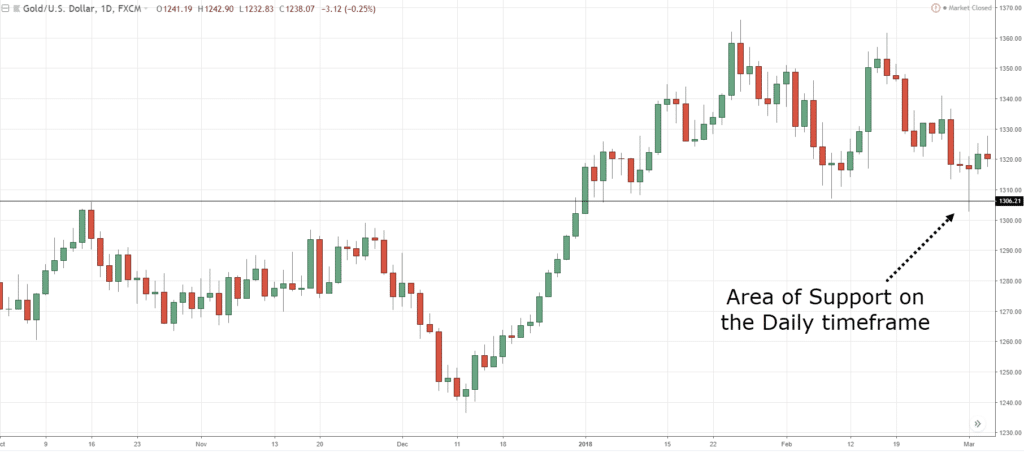
2. Identify an accumulation stage on the lower timeframe (1-hour)
Then, go down to the lower timeframe and identify an accumulation stage.
What you want to see is for the lows of the accumulation stage to lean against Support on the higher timeframe.
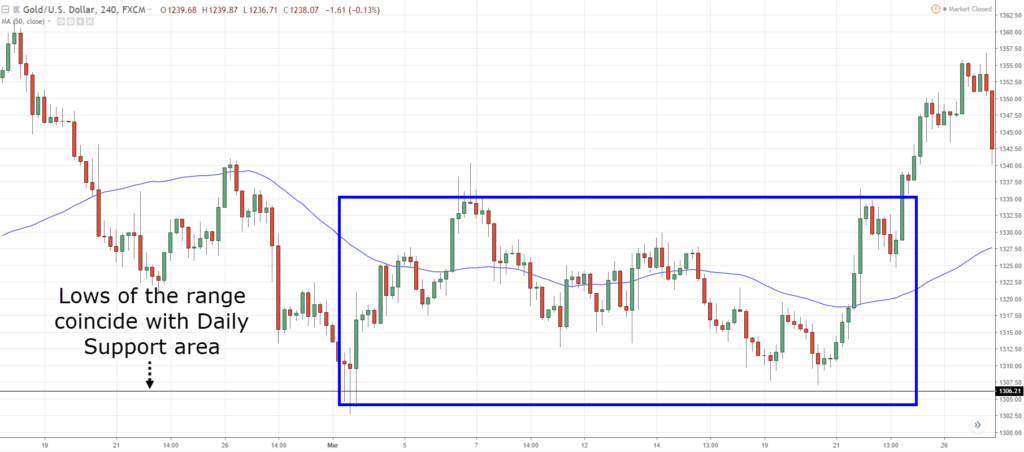
As a general guideline:
If you identify Support on the Daily timeframe, then you can identify an accumulation stage on the 1 to 4-hour timeframe.
Or, if Support is on the Weekly timeframe, then you can identify an accumulation stage on 4-hour to Daily timeframe.
Trend reversal trading setups that work
Now, there are 3 ways you can trade this setup:
- Support & Resistance
- The Breakout
- The Pullback
Assuming you’re using the Daily and 1-hour timeframe combination, these setups will be found anywhere between the 1 to 4-hour timeframe.
Let me explain…
Support & Resistance
If you haven’t realized by now, the low of an accumulation stage is an area of Support (plus it’s leaning against the higher timeframe Support).
So, if you’re expecting higher prices, won’t it make sense to go long at this area?
Here’s what I mean…
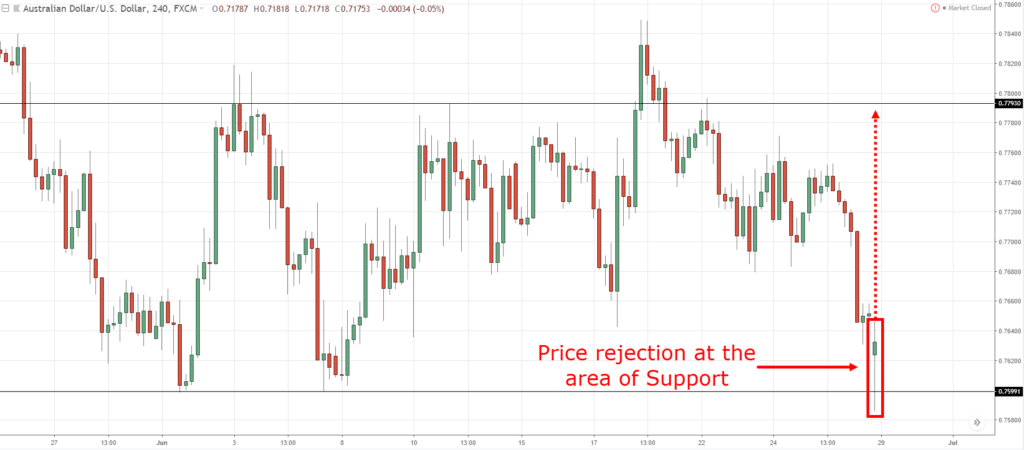
Pros:
This setup offers a very favorable risk to reward as you’re entering in the earliest stage of the move. Imagine, your potential reward if the market breaks out of the accumulation stage?
Cons:
The price may not re-test Support thus not giving you an entry signal.
The Breakout
Alternatively, you can wait for the price to breakout higher and then enter the trade.
An example:
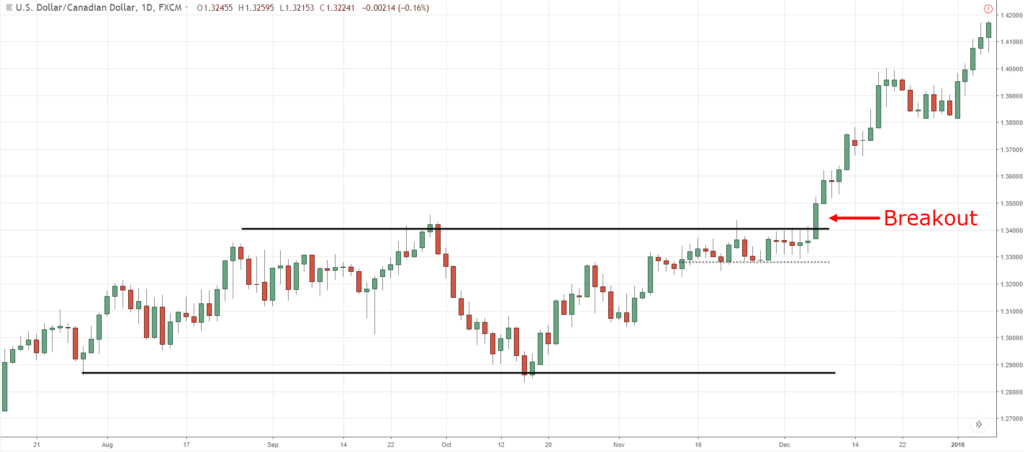
Pros:
You will catch every move as the market transit from an accumulation stage to advancing stage.
Cons:
It could lead to a false breakout.
The Pullback
Lastly… you can wait for the pullback to occur before entering the trade. For example, when the price retraces to previous Resistance turned Support, and forms a bullish reversal candlestick pattern.
Here’s what I mean:
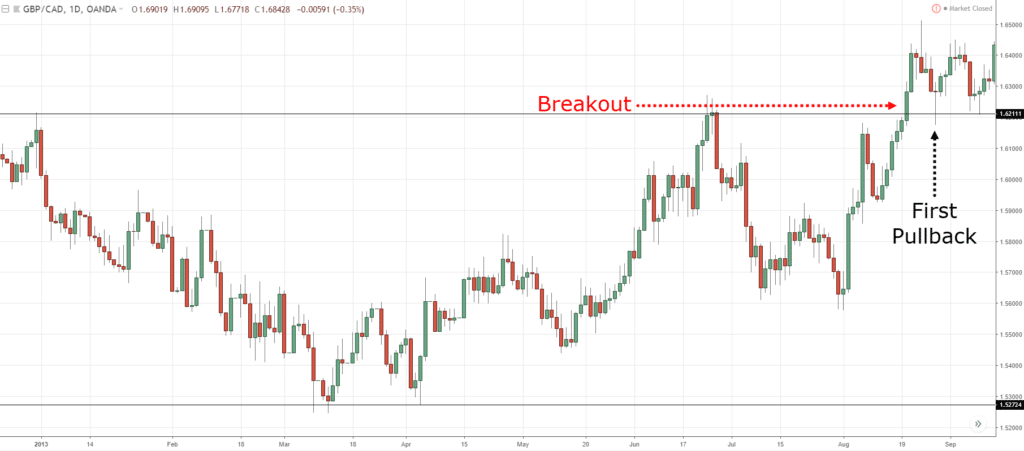
Pros:
This setup offers a favorable risk to reward as you’re entering at an area of value (previous Resistance turned Support).
Cons:
The pullback might never come and you risk missing the move.
Next, you’ll discover how to time your entries, stops and exits when trading trend reversal.
Read on…
Торговый советник
Советник по стратегии активно развивается, новые версии выходят чуть ли не каждую неделю. Поэтому следите за обновлениями на нашем форуме и в оригинальной ветке на ForexFactory.
Советник может выполнять как вспомогательную функцию, чтобы не следить за множеством пар и графиков вручную, так и торговать полностью автоматически. Но, в целом, наиболее эффективный вариант — это использовать советник для получения сигналов, а непосредственно входить в сделку вручную.
У советника достаточно много настроек, вот самые важные из них:
- allowTrading: вкл/выкл. Самый главный параметр, отвечающий за разрешение на торговлю. Если вы хотите, чтобы советник торговал за вас, достаточно его повесить на один график и перевести эту настройку в положение True. Советник будет открывать сделки по всем парам, указанным в графе TradePairs;
- soundAlerts: показ звуковых оповещений при появлении сигнала;
- emailAlerts: включение оповещений на почту;
- stopLossAtZigZagArrow: установка стоп-лосса на стрелочке ZigZag;
- mindBetween2TradesOnSamePair: период в минутах между двумя сделками на одной паре;
- AllowReEntriesOnSamePair: разрешение на доливки по той же паре;
- TradePairs: список торговых пар;
- ChartTemplate: название шаблона, который будет использоваться для фона;
- MoneyManagement: настройки управления капиталом в случае автоматической торговли;
- Magic number Buy/Sell: идентификаторы сделок советника, подробнее читайте тут;
- BuyComment/SellComment: комментарий к ордеру для покупок и продаж;
- MaxSpreadInPips: максимально допустимый спред в пунктах;
- MaxOpenTrades: максимальное число одновременно открытых сделок;
- TrailingMethod…OrderTrail: настройки трейлинг стопа;
- StartHour…TradeOnSunday: настройки времени торговли, если вы, например, хотите запретить ночную торговлю или торговлю в пятницу;
- UseNewsFilter: включение либо отключение фильтра новостей;
- OffsetHoursGMT: о том, что это такое и как настраивается у нас есть отдельный материал на сайте;
- CloseProfitableTradesBeforeNews: закрытие прибыльных сделок перед новостями;
- UseSupportResistanceFilter: фильтр по поддержке/сопротивлению — открываем сделки, только если они находятся на одном из уровней поддержки/сопротивления, то есть, когда у сигнала есть “опора”;
- SR_…: таймфрейм для расчета уровней;
- UseSma200TrendFilter: многие применяют двухсотую среднюю для определения общего (основного) тренда (200 — это примерное количество торговых дней в году);
- ZigZagCandles/MBFXCandles: число свечей, после которых сигнал считается устаревшим.
Далее идут настройки индикаторов ZigZag, MBFX, Trendline; ключевых уровней и скользящей средней.
В режиме Dashboard на графике отображается цветная панель, на которой показывается текущий цвет (направление) каждого из индикаторов и валютных пар, указанных в настройках советника. В последней колонке отображается полноценный сигнал на вход.
Trend reversal trading: Entries, stops and exits
So now the question is…
How do you time your entries in trend reversal trading?
Well, there are two ways to go about it…
- Limit order
- Reversal candlestick pattern
I’ll explain…
1. Limit order
You can set a limit order and enter without “confirmation”.
The good thing is you have a favorable risk to reward on your trades as your entries are near the highs/lows.
The downside is it’s psychologically difficult to buy when the market is falling (and you need the experience to know which levels are worth trading).
2. Reversal candlestick pattern
Or, you can use reversal candlestick patterns to time your entry (like Bullish Engulfing, Hammer, etc.).
So, you’ll enter a trade only after the market shows signs of reversal. However, you risk entering at a much higher price.
Here’s an example…
Bullish reversal candlestick pattern at Support:
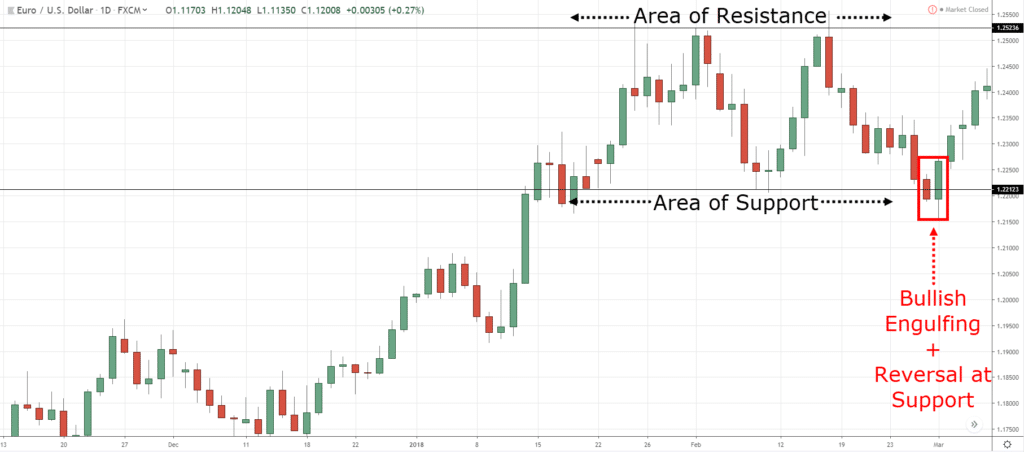
Moving on…
How to set a proper stop loss in trend reversal trading?
When it comes to stop loss, you want to place it at a level that invalidates your trading setup.
This means if your stop loss is hit, then the trend reversal patterns are “broken” and there’s no reason to stay in the trade any longer.
Here’s an example…
Let’s say you buy the breakout of Resistance.
Clearly, if the breakout is real, the price shouldn’t return into the range or else, it’s a failed breakout.
This means you can set your stop loss below Resistance where the price shouldn’t return to.
If it does, you know your trading setup is invalidated and it’s time to get out of the trade.
Here’s what I mean…
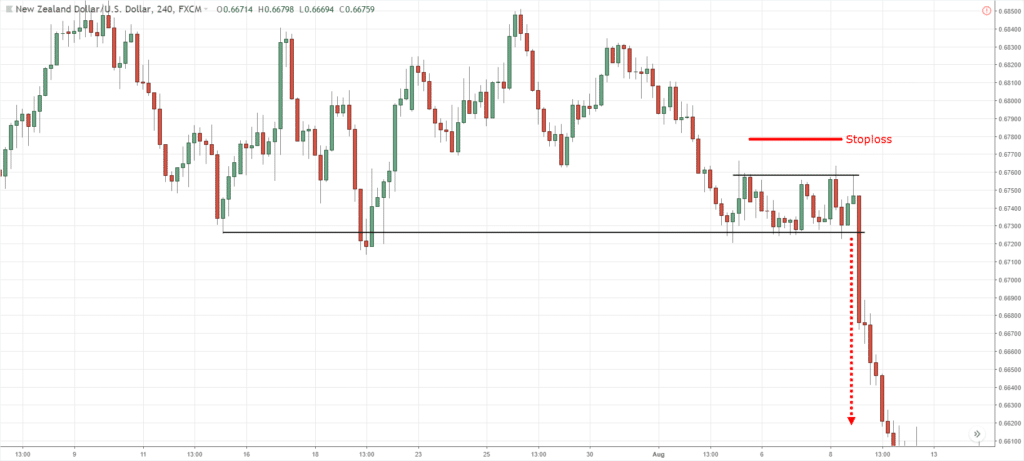
Примеры
 Валютная пара AUDUSD. На графике появилась зеленая стрелочка. MBFX находится в зоне перепроданности, меняется на желтый и выходит, пересекается уровень 30 вверх. Также меняется цвет индикатора TrendLine с красного на зеленый. Сигнальная свеча закрывается выше 15 SMA — можно входить в сделку.
Валютная пара AUDUSD. На графике появилась зеленая стрелочка. MBFX находится в зоне перепроданности, меняется на желтый и выходит, пересекается уровень 30 вверх. Также меняется цвет индикатора TrendLine с красного на зеленый. Сигнальная свеча закрывается выше 15 SMA — можно входить в сделку.
Стоп-лосс ставим немногим ниже стрелочки ЗигЗага, около 38-39 пунктов. В данном случае – если ждать до противоположного сигнала, прибыль получается небольшая, где-то 5 пунктов. Если ждать до смены индикатора TrendLine, то прибыль бы составила 58 пунктов.
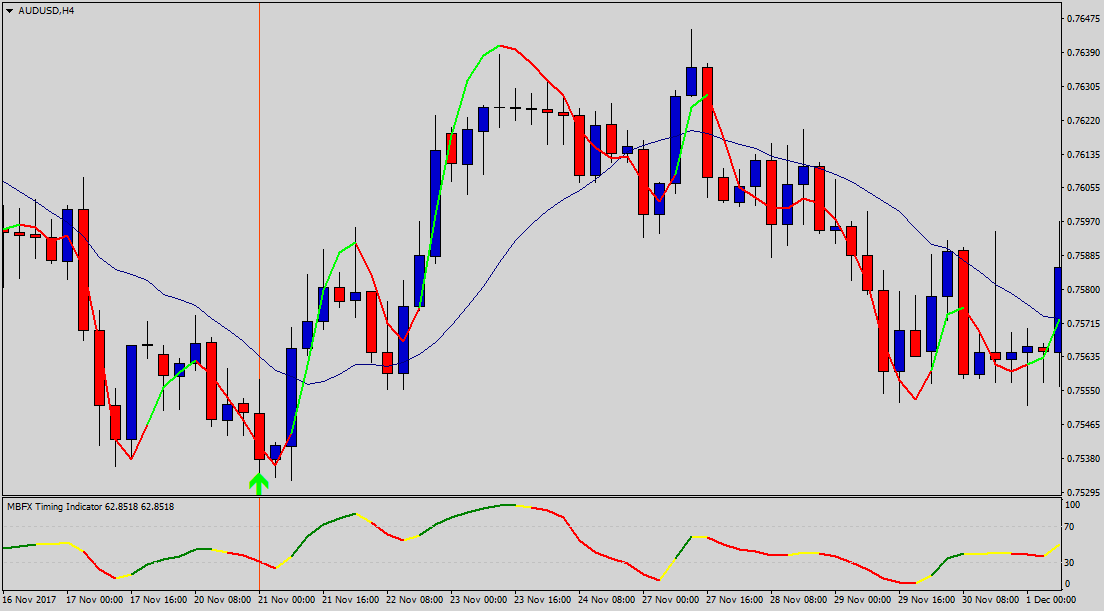 Следующий полноценный сигнал дает прибыль в 54 пункта, если бы мы вышли по противоположной сделке. Выход на смене TrendLine дает потенциальную прибыль в 90 пунктов.
Следующий полноценный сигнал дает прибыль в 54 пункта, если бы мы вышли по противоположной сделке. Выход на смене TrendLine дает потенциальную прибыль в 90 пунктов.
 Пока что разница была не так велика, чего не скажешь о продолжительных трендах. В данном случае – если бы мы ждали другого полноценного сигнала, прибыль бы составила целых 480 пунктов. Это при условии, что стоп-лосс сделки около 40 пунктов. При выходе на смене TrendLine мы бы получили лишь 24 пункта.
Пока что разница была не так велика, чего не скажешь о продолжительных трендах. В данном случае – если бы мы ждали другого полноценного сигнала, прибыль бы составила целых 480 пунктов. Это при условии, что стоп-лосс сделки около 40 пунктов. При выходе на смене TrendLine мы бы получили лишь 24 пункта.
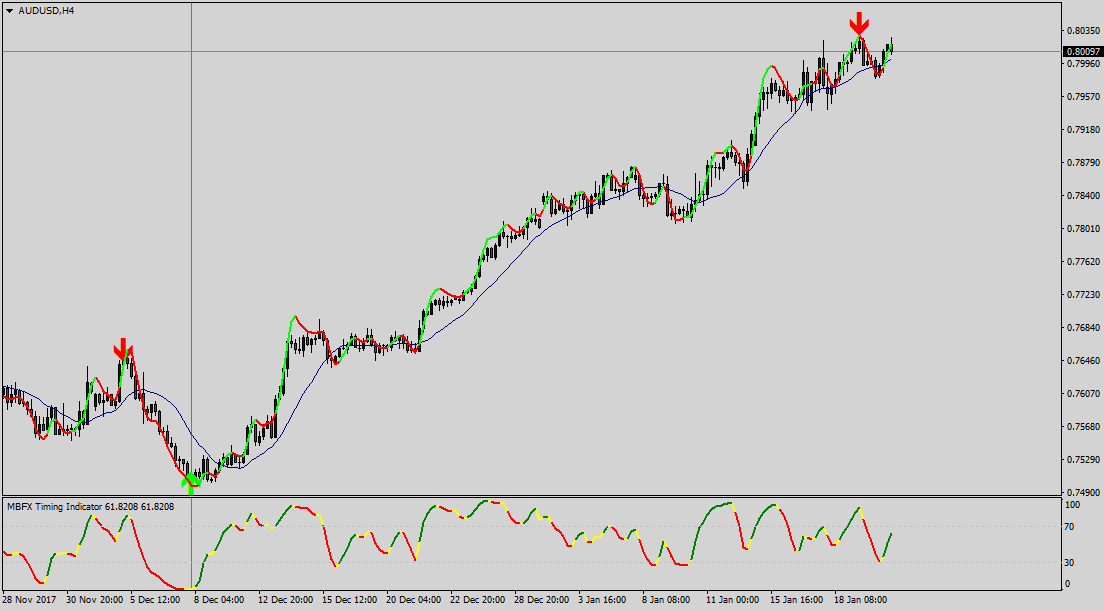 Рассмотрим пример на USDJPY, дневной график. Стоп-лосс вышел довольно большой, 200 пунктов. Выход по TrendLine дал бы нам 256 пунктов. Если бы мы ждали подтверждения полноценного сигнала, позиция все еще была бы не закрыта.
Рассмотрим пример на USDJPY, дневной график. Стоп-лосс вышел довольно большой, 200 пунктов. Выход по TrendLine дал бы нам 256 пунктов. Если бы мы ждали подтверждения полноценного сигнала, позиция все еще была бы не закрыта.
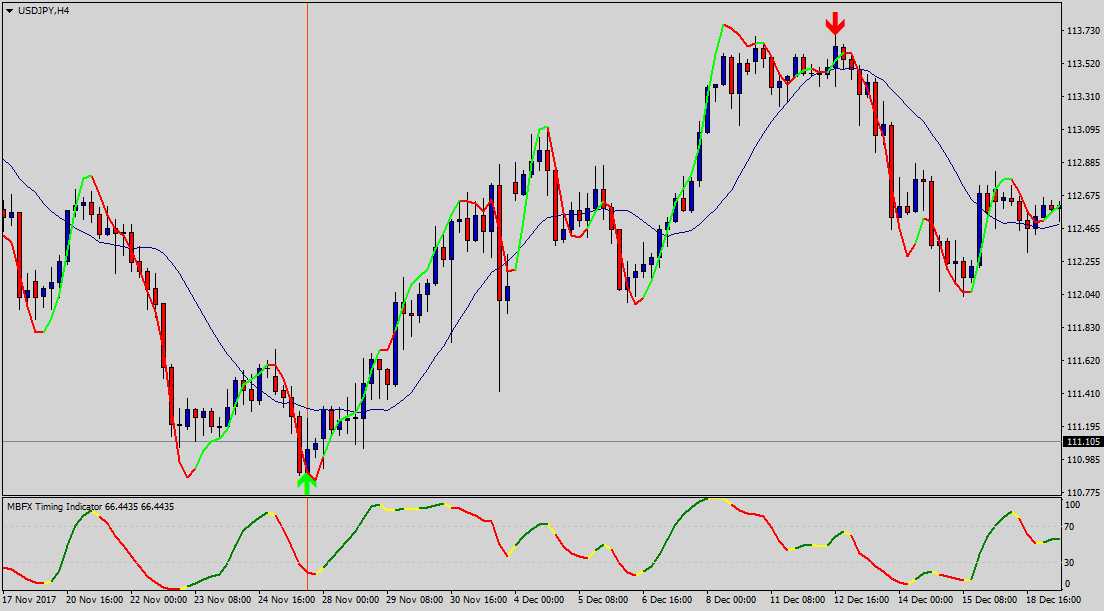 Зато предыдущий сигнал вполне полноценный. Стоп-лосс, опять же, немаленький, 200 пунктов. До полноценного сигнала вышло бы 305 пунктов.
Зато предыдущий сигнал вполне полноценный. Стоп-лосс, опять же, немаленький, 200 пунктов. До полноценного сигнала вышло бы 305 пунктов.
The 4 stages of the markets and why it matters
Now before you can identify trend reversal, you must understand the 4 stages of the markets (a technique I learned from Stan Weinstein).
Why?
Because this gives you warnings that market conditions are about to change — which lets you plan trading decisions ahead of time.
The 4 stages of the markets can be broken down into:
- Accumulation stage
- Advancing stage
- Distribution stage
- Declining stage
Let me explain…
1. The accumulation stage
The accumulation phase looks like a range market in a downtrend.
However, from an order flow perspective, the buyers and sellers are in equilibrium (that’s why the market is in a range instead of a trending market).
Generally in the accumulation stage:
- The ratio of bullish to bearish candles are close
- The 50-period moving average is flattening out
- The price whips back and forth around the 50-period moving average
As time goes by, stops will gradually build up beyond the range as traders long near the lows and short near the highs of the range.
An example:
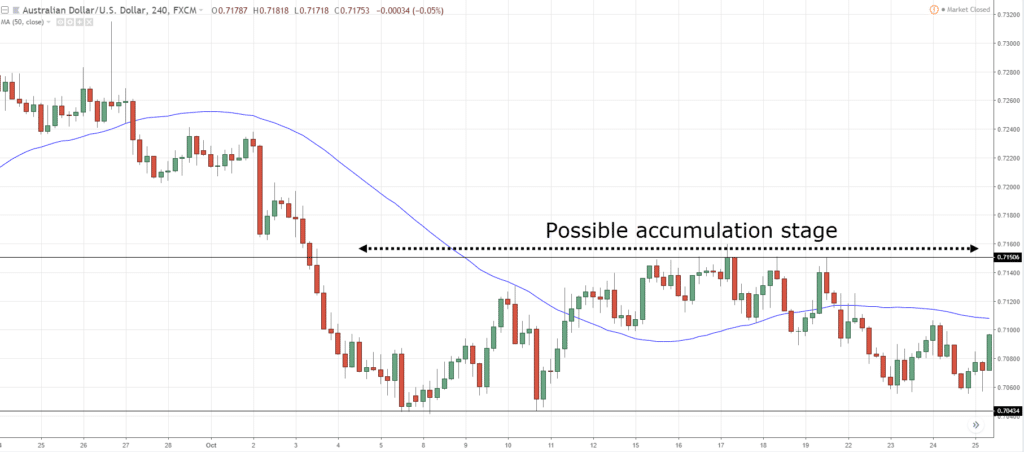
Now…
There’s no guarantee that the market will reverse after trading from here.
But it alerts you to the possibility that the bears are getting weak and the bulls could take control and push the price higher above the highs of the range.
And when this occurs, it leads us to the next phase…
2. The advancing stage
The advancing phase is essentially an uptrend with price making higher highs and lows.
From an order flow perspective, the buying pressure overwhelms the selling pressure (that’s why the market is trending higher).
Generally in the advancing stage:
- There’s more bullish than bearish candles
- The bullish candles are larger than the bearish candles
- The price is above the 50-period moving average
- The 50-period moving average is pointing higher
An example:
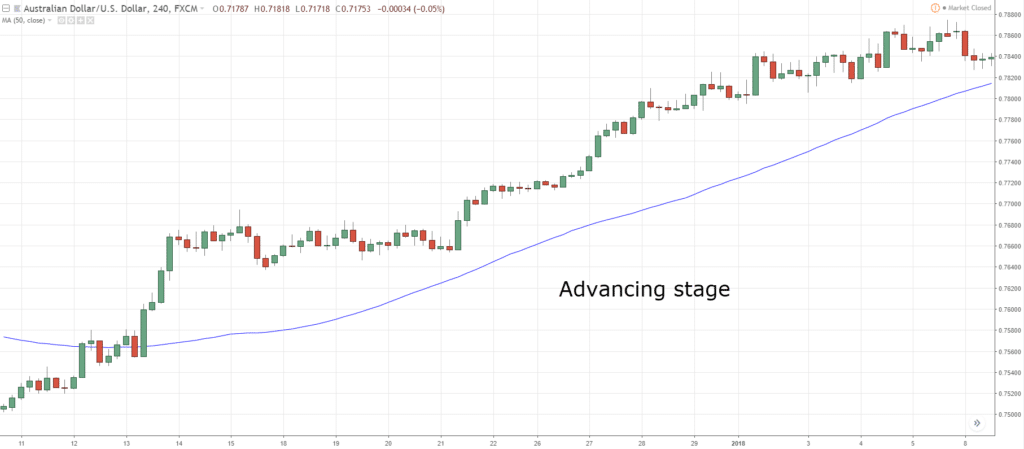
Now…
The advancing stage eventually will need to “take a break” because the early buyers will take profits and sellers will look to short the markets as prices are at attractive levels.
When this occurs, it leads us to the next phase…
3. The distribution stage
The distribution phase looks like a range market in an uptrend.
It tells you the buyers and sellers are in equilibrium (that’s why the market is in a range instead of a trending market).
Generally in the distribution stage:
- The ratio of bullish to bearish candles are close
- The 50-period moving average is flattening out
- The price whips back and forth around the 50-period moving average
As time goes by, stops will gradually build up beyond the range as traders long near the lows and short near the highs of the range.
An example:
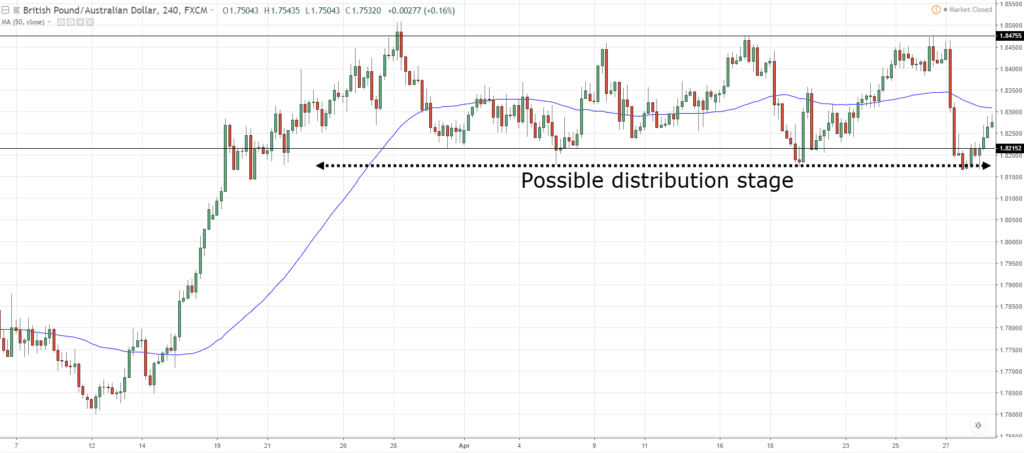
Now…
There’s no guarantee that the market will reverse after trading from here.
But it alerts you to the possibility that the bulls are getting weak and the bears could take control and push price lower below the lows of the range.
4. The declining stage
The declining stage is essentially a downtrend with price making lower highs and lows.
Generally in the declining stage:
- There’s more bearish than bullish candles
- The bearish candles are larger than the bullish candles
- The price is below the 50-period moving average
- The 50-period moving average is pointing lower
An example:
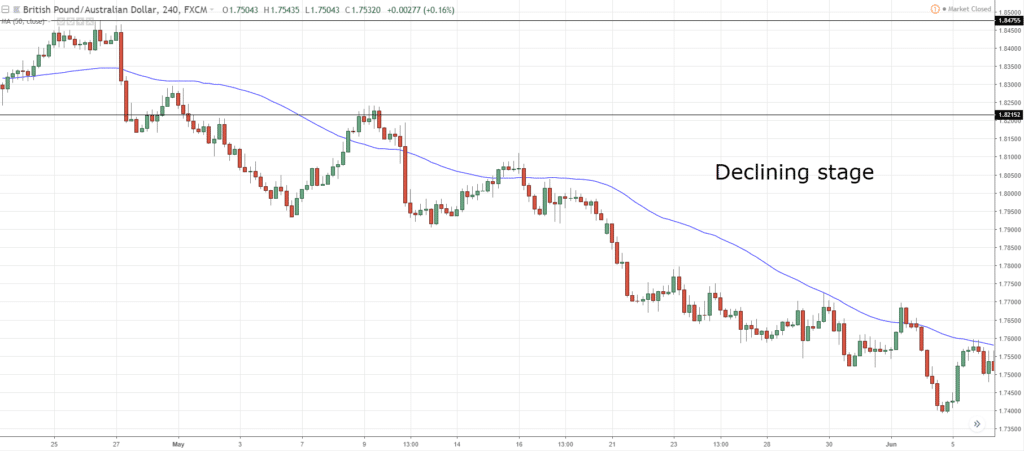
Now, the declining stage eventually will need to “take a break” because the early sellers will take profits and buyers will look to long the markets as prices are at attractive levels.
When this occurs, it leads us back to the accumulation phase.
Do you make these mistakes in reversal trading?
Here’s the thing:
Trend reversal trading can be a profitable way to trade the markets. However, like any other trading strategy, there is a correct and a wrong way to do it.
Before I teach you the correct way to do it, first let me explain how you should NOT trade market reversals.
1. You’re catching a falling knife
For those of you who don’t know what’s catching a falling knife, it means trying to long the markets when it’s plummeting like a rock.
It looks something like this:
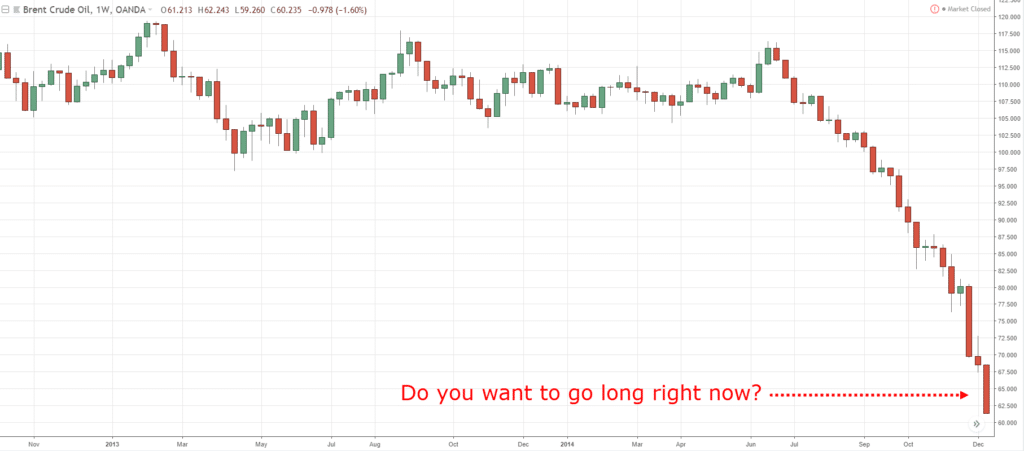
If you ask me…
There’s absolutely no sense in trying to catch a falling knife.
Why?
Because there’s no logical place to put your stop loss; there is no Support or market structure you can refer to.
And usually, the only way to set your stop loss is based on the equity left in your account — a surefire way to lose it.
“Rome was not built in a day, and no real movement of importance ends in one day or in one week. It takes time for it to run its logical course.”
So here’s the thing:
Trends need time to reverse after trading in its original direction. It needs to sucker in “the latecomers to the party” till there is no one left to buy — and that’s when it goes in the opposite direction.
2. You’re entering on the first pullback
Now, another mistake traders make is attempting to trade the first pullback.
This means you go long when you see the market rallies after a huge decline. But often, this type of rally is only a retracement of the existing trend.
Here’s what I mean:
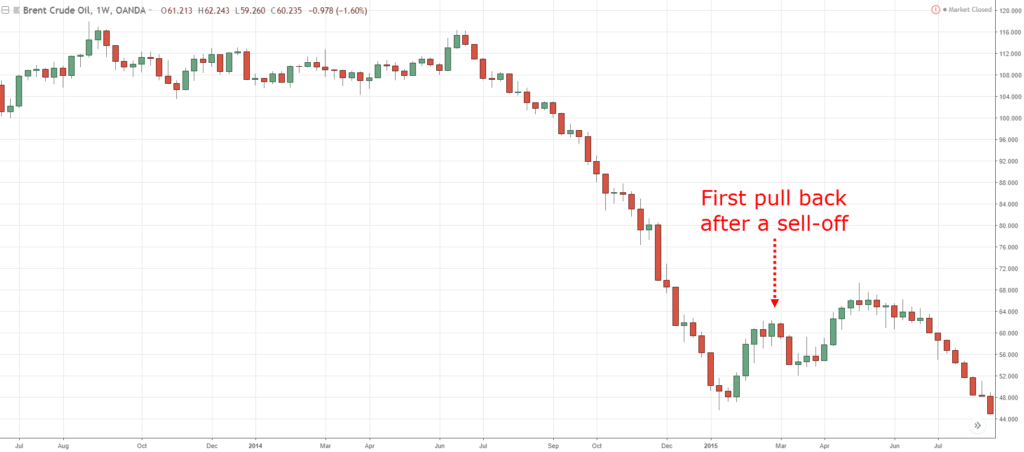
You’re probably wondering:
“Why do traders do this?”
Because of the fear of missing out (FOMO).
You don’t want to miss the next big move, thus you enter as soon as the markets show a sign of reversal. Unknowingly, this sign is usually a retracement of the existing trend.
And even if you catch the bottom in the markets, it’s unlikely you’ll hold the trade for long.
Why?
Think about this…
Prior to this trade, you’d probably tried to catch market bottoms often.
And while doing so, you’d have suffered multiple losses along the way — and this hurts your psychology.
So, when you finally catch a bottom in the markets, you won’t hold the trade for long as you’ll experience the fear of losing (from your earlier trades).
This makes you exit your trades quickly and you end up missing the big move.
Now, let’s move on…
Используемые индикаторы
 Устанавливается система самым обычным способом. В терминал нужно добавить три нестандартных индикатора и специальный шаблон графика. Файлы из архива следует скопировать в каталог данных терминала, открыть который можно через Файл — Открыть каталог данных.
Устанавливается система самым обычным способом. В терминал нужно добавить три нестандартных индикатора и специальный шаблон графика. Файлы из архива следует скопировать в каталог данных терминала, открыть который можно через Файл — Открыть каталог данных.
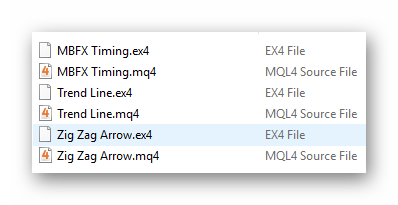 Всего в стратегии используется 4 индикатора:
Всего в стратегии используется 4 индикатора:
- Стандартная простая средняя с периодом 15;
- Индикатор TrendLine — быстрый и чувствительный аналог скользящей, с двухцветной индикацией текущего направления;
- ЗигЗаг в виде стрелочек зеленого и красного цветов;
- В отдельном окне индикатор MBFX.
Тут сразу нужно обратить внимание на то, что стрелочки ЗигЗага перерисовываются. Поэтому на историческом графике вы найдете только те стрелочки, после которых было хоть какое-то движение, даже если полностью все правила стратегии не сошлись
То есть появление стрелочки еще не означает, что сейчас будет сигнал по ТС. Для этого должно быть соблюдено четыре условия.
Summary
In this trend reversal trading strategy guide, you’ve learned:
- Never catch a falling knife or trade the first pullback of a downtrend
- Understand the 4 stages of the market so you know when the price is likely to make a trend reversal
- Trend reversal trading setups: Support & Resistance, the Breakout, and the Pullback
- You can enter on a limit order or wait for a candlestick reversal pattern to time your entry
- You should set your stop loss at a level where if reached, your trading setup is invalidated and you’ll get out of the trade
- There are 2 ways to exit your winning trades, capture a swing or ride the trend
Правила торговли
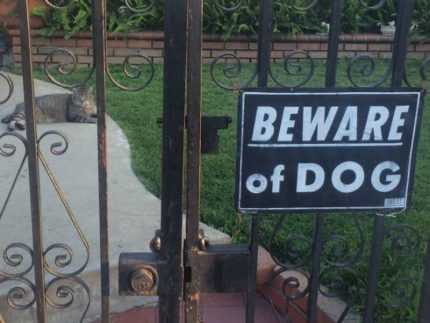 Правила стратегии очень простые, что значит, что торговать по ней смогут даже новички.
Правила стратегии очень простые, что значит, что торговать по ней смогут даже новички.
Правила покупки:
- Появится зеленая стрелка Zig Zag;
- Индикатор MBFX Timing находится в зоне перепроданности (ниже 30%) и указывает на зеленый тренд;
- Индикатор Trend Line показывает зеленым цветом восходящий тренд;
- Свеча пересекает снизу вверх и закрывается выше 15 SMA и только в том случае, если торговля по-прежнему подтверждена 3-мя индикаторами.
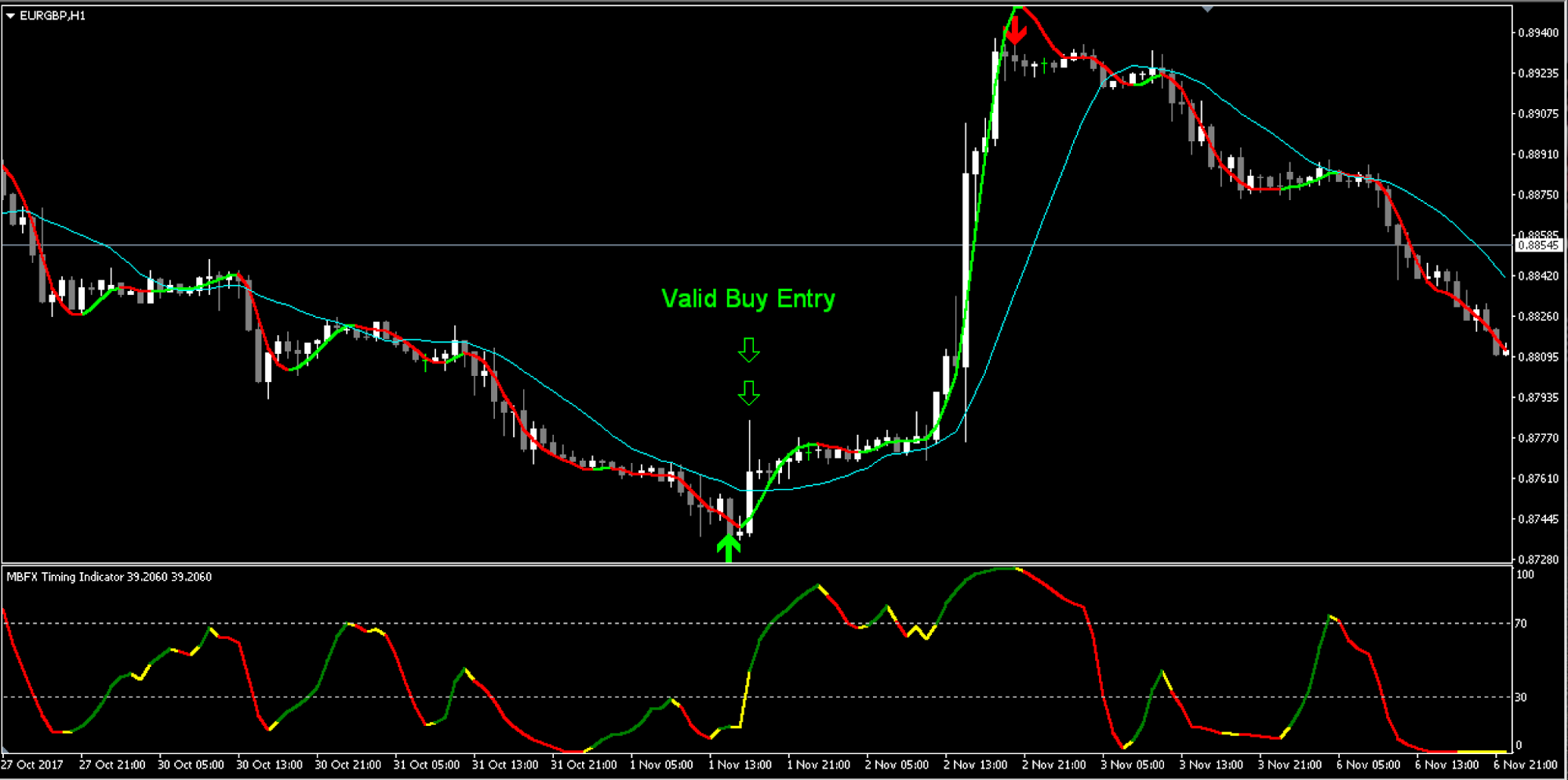 Правила продажи:
Правила продажи:
- Появится красная стрелка Zig Zag;
- Индикатор MBFX Timing находится в зоне перекупленности (выше 70%) и указывает на красный тренд;
- Индикатор Trend Line показывает красным цветом нисходящий тренд;
- Свеча пересекает сверху вниз и закрывается ниже 15 SMA и только в том случае, если торговля по-прежнему подтверждена 3-мя индикаторами.
По сути – первый сигнал в виде стрелочки является предупреждающим и говорит о необходимости обратить внимание на график: возможно, через пару свечей появятся полноценные условия для входа. Когда все три индикатора подтвердили условия для входа, и все находятся в согласии на покупку или продажу по правилам, а свеча пересекается и закрывается выше или ниже 15 SMA, пора входить в позицию
Когда все три индикатора подтвердили условия для входа, и все находятся в согласии на покупку или продажу по правилам, а свеча пересекается и закрывается выше или ниже 15 SMA, пора входить в позицию.





























